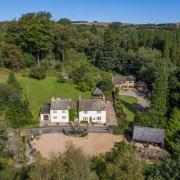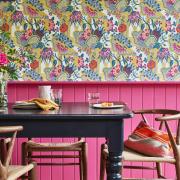Manchester is a city with a colourful history and nowhere is that more evident than in the site David Mottershead chose as the headquarters of his fledgling business.
In 2001 he launched Little Greene, creating sustainable, eco-friendly, luxury paints in shades that reflect the nation’s heritage.
The name is a nod to the heritage of the address in Manchester where David set up his offices. In 1773 the site was occupied by The Little Greene Dye Works where, during the Industrial Revolution, exotic woods imported from across the globe, were processed to create dyes, which were then used to dye the cotton that was at the heart of Manchester’s growth.
David was joined by son Ben and daughter Ruth in 2011. ‘Dad mentioned he was considering stepping back from the business and contemplating the future, and despite having both forged our own careers – Ben in the Metropolitan Police and me as a landscape architect – we both said we’d like to become a part of it,’ says Ruth who is now Little Greene’s creative director.
‘Ben has a very scientific background. He trained as a veterinarian, before joining the police, and my background is very creative, so we both found our niches, Ben in operations and me in marketing.
‘I’m the ‘chief colour curator’, you might say. We split our colours into two areas – the neutrals, and the colours. When we’re looking at developing new colours or retiring others, we look at changes in what people are buying, and trends in interior décor.

‘Neutrals have been popular for ten years but we’re now seeing a step towards stonier tones,’ Ruth adds. ‘There’s a shift in the market from the cooler greys, with a blue undertone, to warmer greys with a red undertone. I felt that from there we would see a move into earthier, richer colours – people wanting to bring more natural tones into their homes, wanting to create more comfortable spaces.
‘So we worked on developing new neutrals, in stone colours – not beige, not magnolia, but colours positioned slightly away from grey with warmer undertones, in yellow, red, pink or green – the Portland Stones, the Rolling Fogs, the Clays, really lovely natural colours.
‘The other side of things is the ‘trend’ colours, these are colours that might be popular for a few years and then we’re on to the next. For example in the last year or two there’s been a lot of terracotta, colours with a lovely orangey-peachy undertone, and this movement will feed into my thinking about the next colour palette to bring together.’

Sweet Treats is the latest collection from Little Greene, a capsule collection of nine warm shades of honey, caramel and chocolate, designed to support an increasing need to create cosy, enveloping interiors and restful spaces.
Little Greene have created a number of period paint colour collections, working with the National Trust and others to discover paints used across the centuries and recreate them for use today. As you’d expect, there are the muted shades of the Georgian era, vibrant Regency tones and darker Victorian shades, but there are also collections of paint colours first used in the 1930s, 50s, 60s and 70s, making it easy for homeowners who want to engage with the age of their home – or who simply love the fashions of a particular era – to find authentic colours.
‘All our heritage colours sit in the colour cards, not as separate collections, except on the website, so you might look specifically for a colour from a particular era, or simply find a colour you love and then discover it’s a Regency colour, or from the 1970s.’
Little Greene introduced their wallpaper collections 15 years ago, a glorious selection inspired by designs used in English homes over centuries.

‘It makes sense to make papers in Little Greene colours so people can choose complementary paints and papers’ Ruth says. ‘We started with English Heritage and more recently we have collaborated with the National Trust. The designs are taken from ceramics, paintings and wall coverings. The archives cover about 300 years of decoration. The earliest we have is from 1760, New Bond Street, and is actually a piece of leather that would have been a wall hanging. It wasn’t until the 1830s that wallpaper really became accessible, with the development of machinery to allow it to be made in rolls, which obviously brought the cost within reach of the middle classes, not just the very wealthy.’
Paint isn’t traditionally associated with the term ‘environmentally friendly’, but Little Greene has worked hard to ensure their paints are as sustainably made and as eco-friendly as possible. Their water-based paints carry almost zero VOCs, and their oil-based paints are made using sustainable vegetable oils. They have also developed a way to recycle their paints, selling the new shades at half the price of their new made paints.
‘Re:mix is made using recycled paint. Sometimes we get paint that’s refused at the door – a customer has changed their mind, for example, or the tin is damaged, or there’s a spill with a pallet of paint, for example. On average we get about 60,000 litres of paint back each year. It’s a bit of an elephant in the room issue across the whole paint industry, because there’s a lot of waste paint and the only way to get rid of it is to incinerate it or send it to landfill.

‘Instead of that, we decided we’d make a recycled product. It’s made of a mix of our bestsellers – Intelligent Matt, Absolute Matt and Intelligent Eggshell – all water-based products. We can make it in 20 different colours. We put the returned paint into colour batches – all the whites, all the pinks, the greens, the blues, etc, and then add tint to it to bring it to be the colour we want it to be. They’re not an exact match for the original colour, but it’s the nearest we can get using the recycling process. It’s a complex and laborious process, but we felt it was important to do.’
Little Greene have just opened their first store in the north, in Wilmslow, adding to the five in London, and in Munich and Paris. Already popular with interior designers and consumers in the UK and Europe, a growing demand from the United States has also led to the brand opening their first showroom on the other side of the Atlantic, in Connecticut.
‘For years we were asked when we’d start selling in the USA,’ Ruth says. ‘American designers would want to know how to get hold of our paints. They really like British products and our focus on the quality of manufacture. There’s no real luxury paint market there, yet, and I think what they like is that we have more limited, curated colour palettes to choose from and, of course, the heritage collaborations we offer through the National Trust.’
littlegreene.com




























